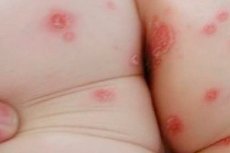Medical expert of the article
New publications
Consequences and complications of streptoderma in children
Last reviewed: 07.07.2025

All iLive content is medically reviewed or fact checked to ensure as much factual accuracy as possible.
We have strict sourcing guidelines and only link to reputable media sites, academic research institutions and, whenever possible, medically peer reviewed studies. Note that the numbers in parentheses ([1], [2], etc.) are clickable links to these studies.
If you feel that any of our content is inaccurate, out-of-date, or otherwise questionable, please select it and press Ctrl + Enter.

The consequences and complications of streptoderma in a child can be very unfavorable. Bacterial infection is always accompanied by the development of inflammation, an infectious process. In the absence of treatment, the risk of sepsis and bacteremia is quite high. It is possible to develop a chronic infection, which will be accompanied by periodic exacerbations, relapses. The danger is that a chronic infection can persist throughout the body, and then can cause various inflammations of internal organs, skin. The infection can penetrate into any organ or system, causing an inflammatory, purulent-septic process there. [ 1 ]
A hidden infection is a big danger. An infection in the urine that is not completely cured can cause relapses. It is also dangerous because the infection can progress.
How does streptoderma end in children?
As a rule, streptoderma lasts 2-3 weeks. To answer the question of how streptoderma ends in children, it is necessary to take into account a number of factors, including the treatment. Usually, with the right treatment and strict adherence to all doctor's recommendations, streptoderma ends with a full recovery. The wounds heal, crusts form, which then fall off. There are no traces or scars after the streptoderma heals.
In some cases, with incorrect, incomplete or untimely treatment, relapses may occur, or the disease may become chronic with periodic exacerbations. In the absence of treatment, failure to follow the doctor's recommendations, a deterioration in the condition may be observed, the infection may progress, affect more and more new areas of the body, create new foci of infection. The pathological process may involve mucous membranes, internal organs, up to the development of sepsis and bacteremia. [ 2 ] Complications of skin infections caused by group A streptococci, such as post-streptococcal glomerulonephritis and acute rheumatic fever, are rare. [ 3 ], [ 4 ], [ 5 ]
Nosebleeds with streptoderma in children
Nosebleeds can be observed in children with streptoderma, but it is associated not so much with streptoderma itself, but with a violation of the normal structural and functional state of the mucous membranes of the nose, with pronounced dysbacteriosis, edema, disruption of the microcirculatory bed and vascular permeability. Bacterial infection, especially streptococcal, is accompanied by bacterial intoxication and a decrease in local immunity. Against this background, the properties of the mucous membranes change, permeability is disrupted, and the tendency to develop bleeding increases. [ 6 ]
If children with streptoderma have nosebleeds, it is advisable to take a course of askorutin. It contains rutin, which affects blood vessels: it normalizes tone, increases permeability, and normalizes the basic properties of blood vessels and blood. [ 7 ], [ 8 ] The second component is ascorbic acid, which also normalizes the condition of the body, including blood vessels, mucous membranes, and removes toxins. [ 9 ] The dosage is prescribed by the doctor individually, but usually children are recommended 0.5 - 1 tablet 2-3 times a day, depending on the body mass index, severity of the pathology, and age.
Использованная литература

